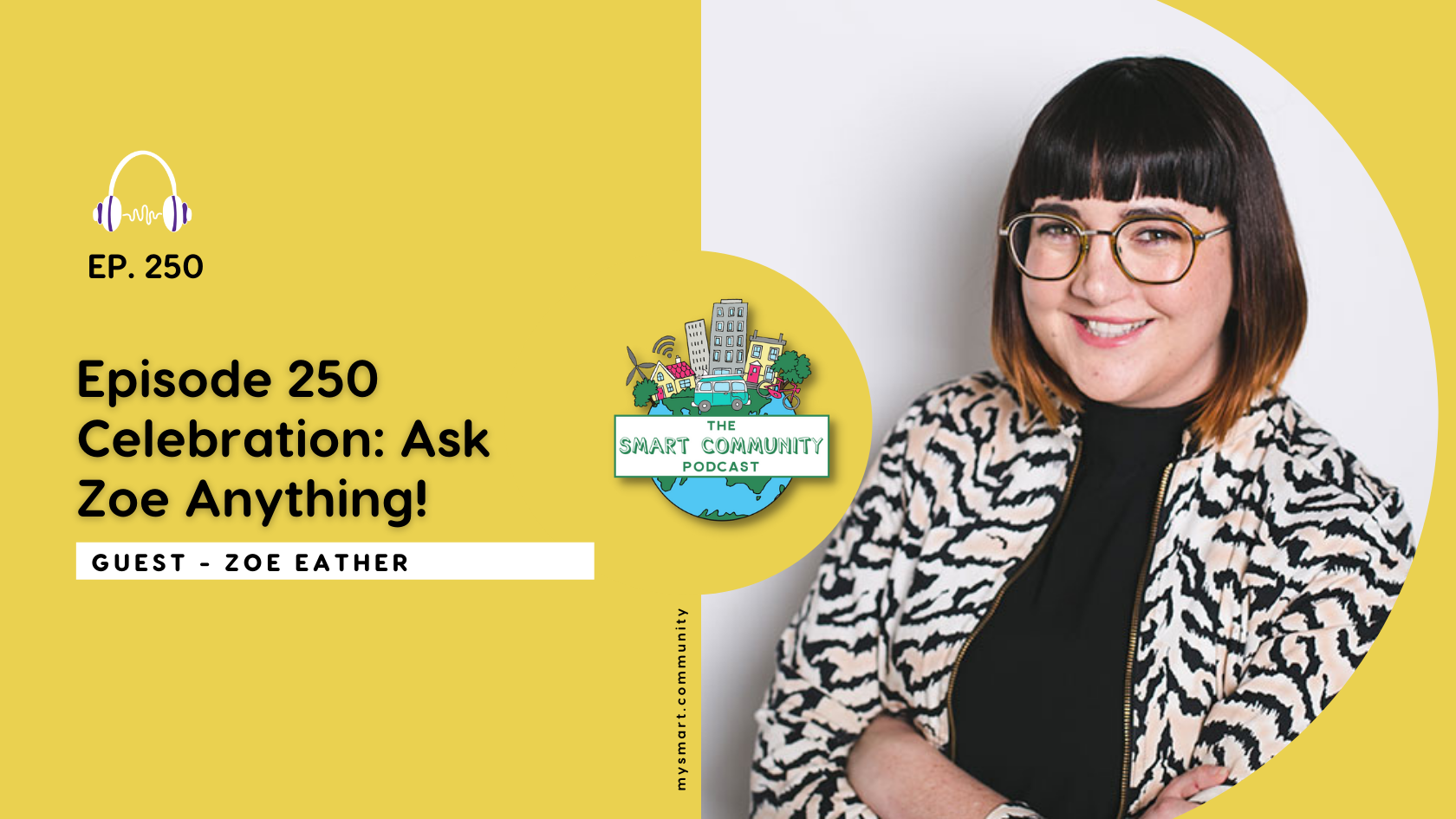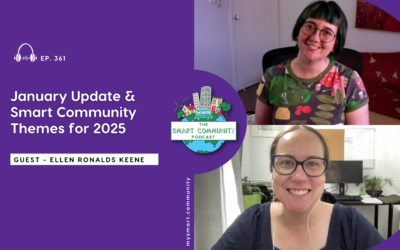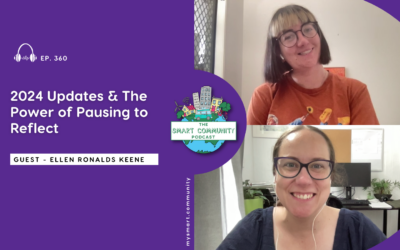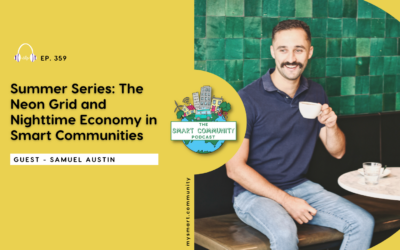Hi #smartcommunity friends! In this episode of the Smart Community Podcast, host Zoe Eather is back in the hot seat! In celebration of this being episode 250, Zoe and producer Ellen Ronalds Keene sat down for a chat where she answers questions from you, the audience of the Smart Community Podcast.
We can’t believe we’re at 250 episodes and now over 128,000 downloads. It’s been just over 3 years of the show and thank you so much for all of you tuning in! Zoe answers 11 questions today from the many that were sent through via LinkedIn. Thank you to those of you who submitted questions! As always, we hope you enjoy listening to this episode as much as we enjoyed making it.
Listen here:
The questions we cover in this episode:
1. Ellen Ronalds Keene – What is your all time favorite street sign?
2. Mark Thomas – What are the most impactful ‘smart’ steps you’re seeing cities take on appropriate city-level action on the impacts of climate change?
3. Cornelia Levy-Bencheton – Any thoughts on bringing academia (a campus is already a “mini city”) into a wider urban community, making internships, partnerships with the local government municipalities possible, or anything else?
4. Jonathan Reichental – What are some best practices for Smart Communities to tell their good news stories?
5. Mike Barlow – What can we do to encourage citizens to participate more fully in decision-making processes?
6. Georgia Eather – What Smart Community strategies / quick wins should governments implement to help combat climate change?
7. Kari Sutton – a) How accessible is the technology used in Smart Cities? We must be cognizant of any financial, physical, and demographic barriers to their adoption. Can it accommodate users that face challenges interacting with technology? Is it affordable?
b) I want to know that the tech is secure and that hackers cannot shut down an entire city because there are flaws in the technology, and I want to ensure that our privacy as individual citizens is protected – what are they collecting the data for? And how is it being used and being stored?
8. Gaya Gounder – What is the best way to bring design thinking into an organisation to uplift the culture of innovation?
9. Venkatesh Gopal – What would it take for every major city to put down an Ultra Low Emission Zone (ULEZ) in its center at least? And why are ULEZ only limited to air pollution?
10. Kylie Nixon – How can we better inform/educate/help property owners and developers on the benefits that walking and cycling infrastructure brings to their bottom line, given that walking and cycling have a strong role in the shape and function of Smart Communities and cities?
11. Oliver Lock – Will there be a new line of Smart Community mugs released to celebrate?
Quotes:
“There’s a number of different initiatives that I’m seeing around the world, but particularly in Australia, where I am, where they’re really trying to embed this kind of smart precinct or digital layer [into Universities] from the very beginning, which is really exciting.”
“[Governance] is so important and Smart Communities actually really need a transformation of governance, as in how things are actually going to happen, who’s responsible for what, who’s accountable for what, who’s going to do what, who’s going to be able to make decisions about what we do with data and technology and all those types of things.”
“If you continue to tell your story, it gets out there and people can take what they need from it, and then share that in their own special way.”
“I think also we need to listen to the people that are in the space of social justice and all these types of things and we bring them into the Smart Community conversation as well. We need them around the table, we need the voices of the people that are going to be most affected around the table. But we need to build trust with them so they feel it’s a safe space to be able to do that.”
“Being able to think about [issues] a bit differently, and then being able to share that information with people then gets people [thinking] and planting those seeds of, ‘Okay, and this makes sense now, I hadn’t had to think about this before in this way.’ So if we can bring that same thinking into this accessible component of technology, then hopefully, we can come up with some better solutions moving forward.”
“A lot of parallels are drawn from design thinking processes to Smart Communities. It’s about fully understanding the problem first, and then exploring a wide range of possible solutions. So these might be technology, these might be new ways of thinking, different communication methodologies or different data that’s available. And then actually using an iterative approach to test and prototype.”
“[We need to make cities] more comfortable for humans, and start to think about the infrastructure that we need to set this up, and consider walkability, cyclability, green space and the things that humans love. But also, then we can use data to be able to make some of these decisions, and continue to make [cities] better for humans by getting their feedback, so we can continue to make these places more accessible, livable, and sustainable.”
Links mentioned in this episode:
- SCP E111 and SCP E187 with Mark Thomas
- SCP E114 and SCP E115 with Mike Barlow and Cornelia Levy-Bencheton
- SCP E77 with Jonathan Reichental
- SCP E295 with Jack Barton
- SCP E249 with Niels Wouters
- SCP E175 with Kim Houghton
- SCP E162 and SCP E221 with Chad Ramage
- SCP E166 and SCP E177 with Debbie Reynolds
- SCP E69 with Nicole Stephensen
- SCP E246 with Dawid Jacobs
- SCP E97 with Kylie Nixon
- SCP E41 and SCP E222 with Oliver Lock
- Teacher Wellbeing Podcast by Ellen Ronalds Keene
- Paid by the World Podcast by Mike Barlow
Connect:
Find the full show notes at: www.mysmart.community
Connect with me via email: hello@mysmart.community
Connect with My Smart Community via LinkedIn or Twitter and watch on YouTube
The Smart Community Podcast is produced by Perk Digital






0 Comments